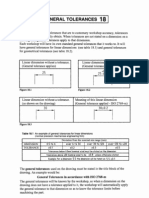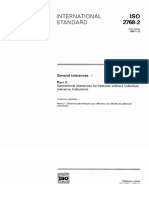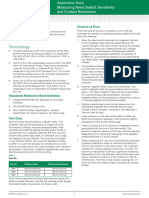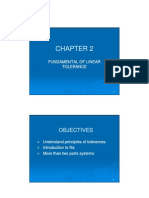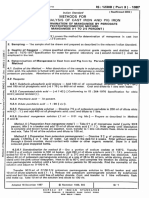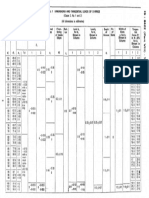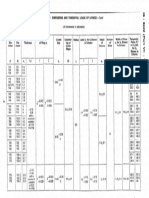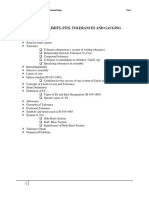Is 2102-2 (Iso 2768-2) - 4
Is 2102-2 (Iso 2768-2) - 4
Uploaded by
Svapnesh ParikhCopyright:
Available Formats
Is 2102-2 (Iso 2768-2) - 4
Is 2102-2 (Iso 2768-2) - 4
Uploaded by
Svapnesh ParikhOriginal Title
Copyright
Available Formats
Share this document
Did you find this document useful?
Is this content inappropriate?
Copyright:
Available Formats
Is 2102-2 (Iso 2768-2) - 4
Is 2102-2 (Iso 2768-2) - 4
Uploaded by
Svapnesh ParikhCopyright:
Available Formats
IS 2102 ( Part2) : 1993
IS0 2769-2 : 1999
Table 1 - General tolerances on straightness 5.2.3 Perpendicularity
and flatness
The general tolerances on perpendicularity are given in table 2.
Values in millimetres
The longer of the two sides forming the right angle shall be
Straightness and flatness tolerances for ranges
~Tu~~~~~~~~n~~~~~!~~
taken as the datum; if the sides are of equal nominal length,
either may be taken as the datum.
Table 2 - General tolerances on perpendicularity
Values in millimetres
l-i 0.02 0.05 0.1 0.2 O,3 0.4
Perpendicularity tolerances for ranges of
K 0.05 0.1 0.2 O,4 0.6 0,B Toler- nominal lengths of the shorter side
L 0.1 0.2 0.4 0.8 1.2 1.6 ante
class over 100 over 300 over 1 WO
up to loo
up to 300 up to 1 IlcCl up to 3 ooo
Ii 02 0.3 0.4 0.5
5.1.2 Circularity K 0.4 0.6 0.8 1
L O-6 1 1.5 2
The general tolerance on circularity is equal to the numerical
value of the diameter tolerance, but in no case shall it be greater
than the respective tolerance value for circular radial run-out
5.2.4 Symmetry
given in table 4 (see examples in clause 8.2).
The general tolerances on symmetry are given in table 3. The
longer of the two features shall be taken as the datum; if the
5.1.3 Cylindricity features are of equal nominal length, either may be taken as the
datum.
General tolerances on cylindricity are not specified.
NOTE - The general tolerances on symmetry apply where
NOTES - at least one of the two features has a median plane, or
- the axes of the two features are perpendicular to each other.
1 The cylindricity deviation comprises three components : circularity
deviation, straightness deviation and parallelism deviation of opposite See examples in clause 8.5
generator lines. Each of these components is controlled by its in-
dividually indicated or its general tolerance.
Table 3 - General tolerances on symmetry
2 If, for functional reasons, the cylindricity deviation has to be smaller Values in millimetres
than the combined effect (see clause 8.31 of the general tolerances on
circularity, straightness and parallelism, an individual cvlindricity toler- Symmetry tolerances for ranges of
ance in accordance with IS0 1101 should be indicated for the feature Toler- nominal lengths
concerned. ante
class over 100 over 300 I over 1 WO
up to loo
up to 3cm up to 1 ooo upto
Sometimes, e.g. in the case of a fit, the indication of the envelope
requirement @ is appropriate. H 0.5
K 0.6 0.8 1
L 0.6 1 I,5 2
5.2 Tolerances for related features
5.2.1 General
5.2.5 Coaxiality
The tolerances specified in 5.2.2 to 5.2.6 apply to all features
which are in relation to one another and which have no respec- General tolerances on coaxiality are not specified.
tive individual indication.
NOTE - The deviation in coaxiality may, in an extreme case, be as
great as the tolerance value for circular radial run-out given in table 4.
5.2.2 Parallelism since the deviation in radial run-out comprises the deviation in coaxial-
ity and the deviation in circularity.
The general tolerance on parallelism is equal to the numerical’
value of the size tolerance or the flatness/straightness toler- 5.2.6 Circular run-out
ance, whichever is the greater. The longer of the two features
shall be taken as the datum; if the features are of equal nominal The general tolerances on circular run-out (radial, axial and any
length, either may be taken as the datum (see clause 8.4). surface of revolution) are given in table 4.
.2
You might also like
- 4.14 Welding in Cold-Formed Zones: BS EN 1993-1-8:2005 EN 1993-1-8:2005 (E)No ratings yet4.14 Welding in Cold-Formed Zones: BS EN 1993-1-8:2005 EN 1993-1-8:2005 (E)5 pages
- JIS B 2702 1987, Hot Coiled Helical SpringsNo ratings yetJIS B 2702 1987, Hot Coiled Helical Springs9 pages
- Poster - Form and Position Tolerances - EN - 10037106No ratings yetPoster - Form and Position Tolerances - EN - 100371061 page
- Hommel-Etamic Measuring Systems: Geometrical Tolerancing in PracticeNo ratings yetHommel-Etamic Measuring Systems: Geometrical Tolerancing in Practice1 page
- Aeroelastic Flutter R0 11 10 17 5 Part 5No ratings yetAeroelastic Flutter R0 11 10 17 5 Part 51 page
- Identification of Delamination FINAL - de - FINALNo ratings yetIdentification of Delamination FINAL - de - FINAL6 pages
- Aluminium Conductors For Overhead Transmission Purposes: Indiizn StandardNo ratings yetAluminium Conductors For Overhead Transmission Purposes: Indiizn Standard10 pages
- 042021_AEE_Civil_Panchayati_Raj_Main CBRE_Paper_II_Question PaperNo ratings yet042021_AEE_Civil_Panchayati_Raj_Main CBRE_Paper_II_Question Paper20 pages
- SN009a Effective Lengths and Destabilizing Load Parameters For Beams and Cantilevers - Common CasesNo ratings yetSN009a Effective Lengths and Destabilizing Load Parameters For Beams and Cantilevers - Common Cases7 pages
- Wuolah Free Manufacturing Processes ExercisesNo ratings yetWuolah Free Manufacturing Processes Exercises70 pages
- Ilovepdf - Merged - 2024-02-25T160505.161No ratings yetIlovepdf - Merged - 2024-02-25T160505.1617 pages
- Fundamentals of Limits, Fits & TolerancesNo ratings yetFundamentals of Limits, Fits & Tolerances24 pages
- Aluminium Conductors For Overhead Transmission Purposes: Indian StandardNo ratings yetAluminium Conductors For Overhead Transmission Purposes: Indian Standard9 pages
- Measuring Reed Switch Sensitivity and Contact Resistance: Sources of ErrorNo ratings yetMeasuring Reed Switch Sensitivity and Contact Resistance: Sources of Error3 pages
- Summary-Geometrical Tolerance - I - 07-2006 - Rev ANo ratings yetSummary-Geometrical Tolerance - I - 07-2006 - Rev A10 pages
- Two Way Slab Direct Design Method (DDM) : Eng - Loai TarabulsiNo ratings yetTwo Way Slab Direct Design Method (DDM) : Eng - Loai Tarabulsi45 pages
- 0-Design of Mono-Symmetric and Asymmetric Sections in CompressionNo ratings yet0-Design of Mono-Symmetric and Asymmetric Sections in Compression2 pages
- Copper Trolley Wire: Standard Specification ForNo ratings yetCopper Trolley Wire: Standard Specification For5 pages
- 016 Buckling Analysis V2I6 IJERTV2IS60445No ratings yet016 Buckling Analysis V2I6 IJERTV2IS604459 pages
- Cylindrical Compression Helix Springs For Suspension SystemsFrom EverandCylindrical Compression Helix Springs For Suspension SystemsNo ratings yet
- High-Performance Gradient Elution: The Practical Application of the Linear-Solvent-Strength ModelFrom EverandHigh-Performance Gradient Elution: The Practical Application of the Linear-Solvent-Strength ModelNo ratings yet
- Software For Calculation of Involute Splines According To ISO 4156 and ANSI B92.2MNo ratings yetSoftware For Calculation of Involute Splines According To ISO 4156 and ANSI B92.2M2 pages
- Retaining Compound Design Guide: Securing Cylindrical AssembliesNo ratings yetRetaining Compound Design Guide: Securing Cylindrical Assemblies20 pages
- Integrated Freewheels FXM: For Bolting To The Face With Sprag Lift-Off XNo ratings yetIntegrated Freewheels FXM: For Bolting To The Face With Sprag Lift-Off X6 pages
- ETImail - Online Geometric Dimensioning and Tolerancing (GD&T) NewsletterNo ratings yetETImail - Online Geometric Dimensioning and Tolerancing (GD&T) Newsletter7 pages
- Nissan Almera n16 2001 Electronic Repair Manual 200No ratings yetNissan Almera n16 2001 Electronic Repair Manual 2001 page
- TLE 8 Module 2 3 Performing Mensuration and CalculationNo ratings yetTLE 8 Module 2 3 Performing Mensuration and Calculation33 pages
- H 2000 6021 0D C Inspection Software LathesNo ratings yetH 2000 6021 0D C Inspection Software Lathes108 pages
- BS-1881-Part-117-83 Spli Tensile Strength PDFNo ratings yetBS-1881-Part-117-83 Spli Tensile Strength PDF10 pages
- Instruments Types and Performance Characteristics ReportNo ratings yetInstruments Types and Performance Characteristics Report30 pages
- 'Non-Orientedelectricalsteelsheets and Stripsformagnetkcircuits-Specification (No ratings yet'Non-Orientedelectricalsteelsheets and Stripsformagnetkcircuits-Specification (19 pages
- ISO 2232 - 2022 - ISO 2232 - 2022 Round Non-Alloy Steel Wires For General Purpose Wire RopesNo ratings yetISO 2232 - 2022 - ISO 2232 - 2022 Round Non-Alloy Steel Wires For General Purpose Wire Ropes11 pages









